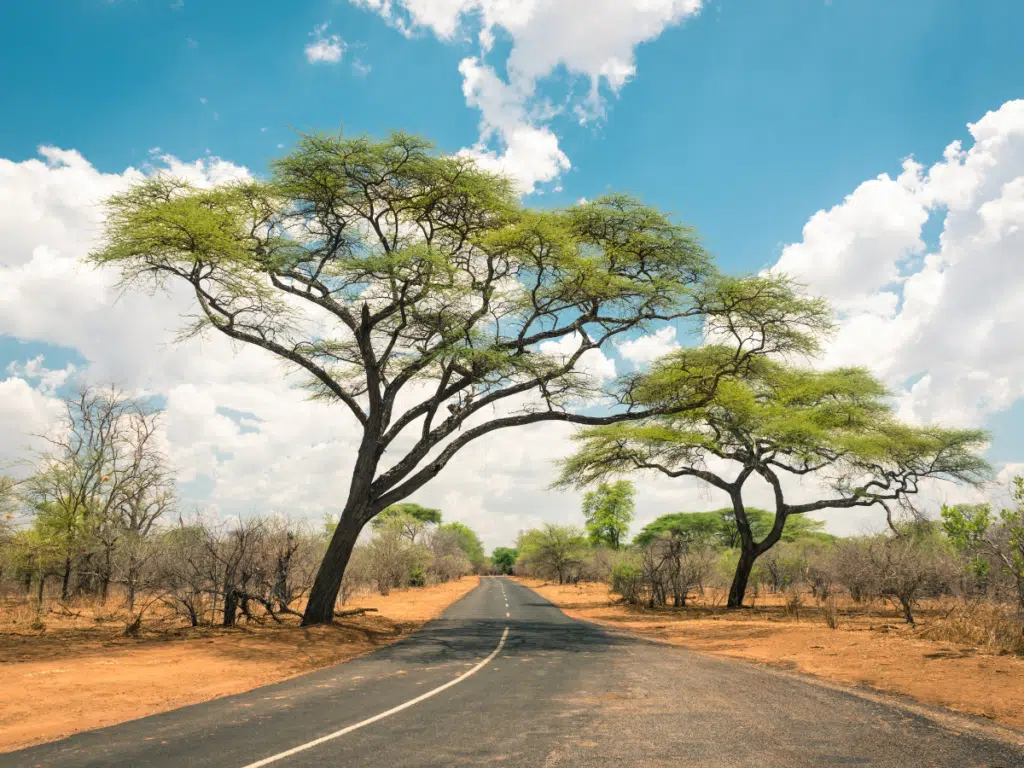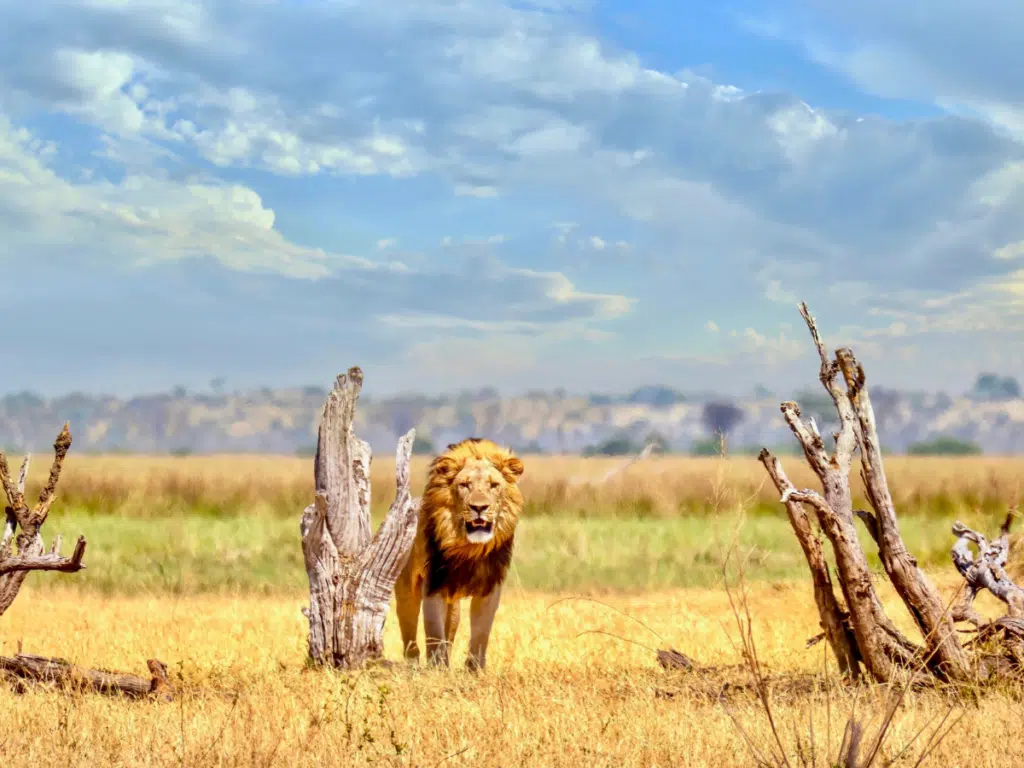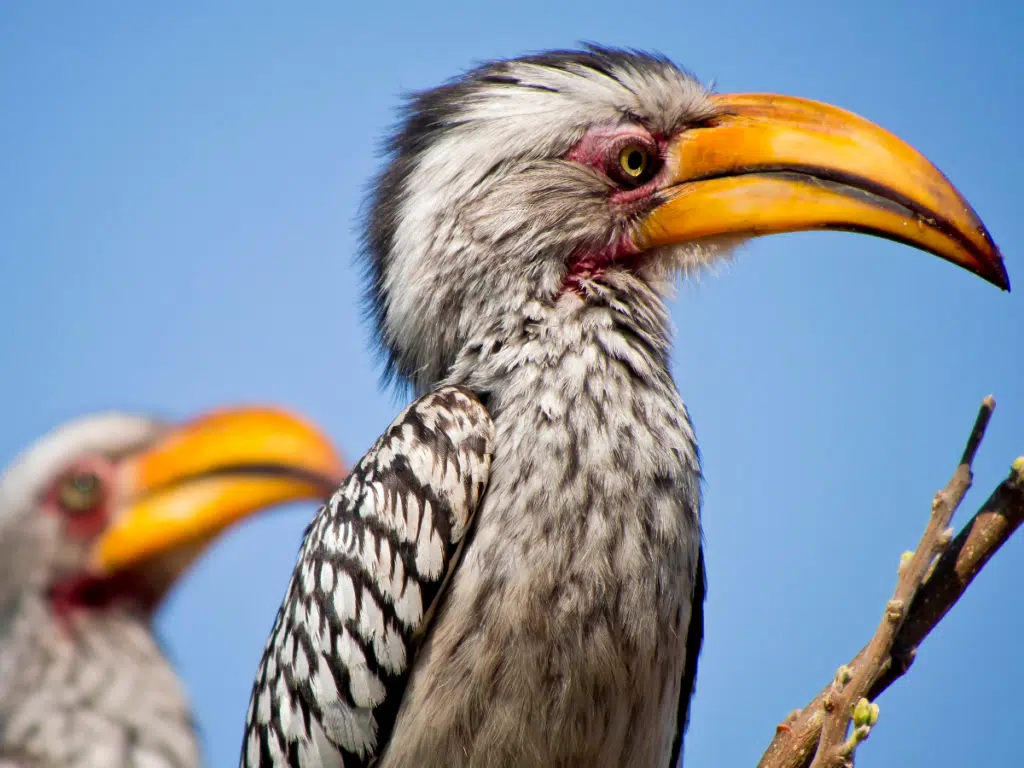Chobe National Park Botswana Complete Traveler’s Guide
Chobe National Park in northwestern Botswana covers an area of 11,700 square kilometers. This park is known as one of the most spectacular African safari wildlife parks. It’s famous for its wildlife and for the dense concentrations of large game in the park.
Chobe National Park is one of Botswana’s leading conservation areas, offering visitors excellent opportunities to see wildlife in their natural habitat. Expect to see hundreds of animals during your safari at Chobe National Park, including elephants, lions, rhinos, zebras, buffalo, and more.
In this ultimate guide to Chobe National Park, learn all about this incredible safari park and the treasures it holds. From impressive landscapes to breathtaking wildlife, you’ll experience the safari of your life at Chobe National Park, Botswana.

This post contains affiliate links that may reward me monetarily or otherwise when you use them to make qualifying purchases – at no cost to you. As an Amazon Associate, I earn from qualifying purchases. For more information, please read our disclosure policy.
Chobe National Park
The park was established in 1967 to protect various ecosystems. Most notable is the perennial Chobe River system that forms a huge wetland with several lakes and rivers. The Chobe River runs through central parts of the park and empties into the great lake called Chirisa Kulana. The river system also serves as a natural boundary between two neighboring protected areas: Kgatleng Game Reserve and Orapa Wildlife Sanctuary.
The park has four areas: Ngwenzumba Pans, Linyanti, Savute and the Chobe Riverfront. Within these areas, there are opportunities for visitors to explore the wildlife that call the park home. Chobe National Park is particularly known for its large elephant population.
Both day and overnight safaris will get you closer to the wildlife. One of the most popular attractions is a Chobe River Cruise. It offers beautiful views and a great opportunity to see elephants up close.
History of Chobe National Park Botswana
It’s hard to believe, but Chobe National Park in Botswana has a long and varied history. The park was initially known as “Mababe” and was proclaimed a reserve in 1907 by Sir Charles Eliot. The area only covered 965 square kilometres at that time. In 1924, it was extended to its current size of 11,700 square kilometres.
In 1959, the Selinda Spillway was built by Malcolm Colegate to provide fresh water for agriculture in parts of Zimbabwe, Zambia, and Botswana. The spillway also created an important wildlife corridor between these countries.
The first safari camp in the park was Ngoma Safari Lodge, opening its doors in 1963. That same year saw the beginning of commercial fishing on the Chobe River, which continues today with increasing success each year.
Botswana gained independence from Great Britain in 1966. This led to major changes throughout the country, including those affecting Chobe National Park. New game laws were enacted. Some areas were closed for hunting, while others were opened. As well, anti-poaching measures stepped up considerably.
Since then, the park has grown in popularity as a top safari destination. It has become especially popular with those seeking an authentic African Photo Safari experience.
Abundant Wildlife & Bird-life
Chobe National Park is home to about 120,000 elephants. This makes it one of the largest concentrations of elephants in the world. Visitors come here to see these majestic creatures in their natural habitat. They can spot buffalo herds as well, and experience amazing lion and leopard sightings.
The river has an unbelievable abundance of wild animals, such as hippos and crocodiles. The park has many rare birds, like the African Fish eagle and African Skimmer. Most of these are highly prized by wildlife photographers for their beauty and rarity.
Where to Stay in Chobe National Park
Looking to stay at Chobe park? There is no shortage of accommodations. The majority are along the river. Whether you are looking for a luxurious lodge or something more rustic. You can find what you need.
In addition, Kwando Reserve offers guests a range of activities. Enjoy wildlife encounters in and out of water, as boats cruise the river. This private reserve is definitely worth exploring if you have the opportunity.
And if that’s not enough, consider visiting Botswana’s Moremi and Kasane. There is something for everyone on safari!

Location
Kasane is a town in northeastern Botswana, on the banks of the Chobe River. It’s an excellent base when visiting Chobe National Park.
Chobe National Park borders Zimbabwe, Zambia and Namibia, making it easy for day trips or excursions from Victoria Falls. There are many safari offerings in Botswana and Namibia that can be combined with a visit to Chobe National Park. For example, visitors can explore Okavango Delta by mokoro (a traditional dugout canoe), go game viewing on horseback, or enjoy a bush walk.
A Different Perspective of Chobe
When most people think about safaris, they imagine a jeep ride in the African bush searching for lions and elephants. While this is an unforgettable experience, there are other ways to view wildlife in Chobe National Park.
The river is the best place to see wildlife and birds. This can include a boat trip where guests can take spectacular images of elephants and hippos. There are also fly-in safaris, scenic flights, and mokoro canoe (traditional dug-out canoe) excursions on the Delta. Or try a camping safari! Visitors can explore Chobe in a variety of ways.
There are many options for an African Photo Safari, too, apart from traditional jeep safaris. Try a walking safari or river cruise, for example. The campsites in Chobe are a popular option for longer stays. They offer visitors incredible views of Africa’s biggest national park from tents or chalets. Houseboats offer varying degrees of luxury.
The park also has 450 species of birds. Make sure you bring your binoculars! Catch and release fishing is available, too, if you want to try your hand at landing some of Chobe’s famous tigerfish.
How to Get to Chobe National Park
The best way to enter the park is by flying to the airport in Kasane. There are several lodges and camps near the airport, making it easy to get settled in before starting your photo safari.
If you’re not staying at a lodge on the Chobe Waterfront or in Kasane, you’ll need to fly into Livingstone Airport in Zambia. From there you’ll catch a small aircraft to the park. Keep your camera ready as they fly low over the Zambezi River, giving you some amazing photo opportunities of Victoria Falls! Upon arrival at Chobe National Park airstrip be sure to have a 4×4 vehicle ready to take you into the heart of this incredible wildlife reserve.
Highlights of a Chobe National Park Safari
When you visit Chobe National Park, there are endless opportunities to see wildlife in its natural habitat. The park is home to elephants, lions, buffalo, and a variety of other animals. You can also enjoy a variety of activities while you’re there.
One highlight of a safari is the unique lodging that is available. For example, you can stay in a tree house or at the Malilangeni Safari Club. These lodges offer an unforgettable experience, allowing you to get up close with nature.
Another significant activity is hiking. There are many well-protected trails to lead you through these areas. Grab that camera! You’ll want to take pictures along the way! Don’t worry about wildlife safety, thanks to the rangers and conservationists who patrol these areas daily.
Things To Do in Chobe National Park
If you want an adventure, Chobe National Park is a great place for it. There are many safaris available. I’m positive one will fit your adventurous nature. Looking to experience the land up close? Consider a walking safari. If photographing wildlife from the water’s edge, perhaps a river cruise down the Chobe.
River Safari
A Chobe river boat tour is a perfect way to experience the beauty and tranquillity of the Chobe River. It’s a great way to relax and enjoy Botswana’s natural environment. It offers an exciting opportunity to learn about the country. Boats cruises along the River offer passengers a unique opportunity to explore the riverbanks and photograph the wildlife.
They also provide an opportunity to learn about the local culture and history, as well as its natural environment. In addition, river boat cruises offer a great way for guests to meet other travellers while exploring Botswana’s unique culture.
Chobe Game Drive
One of the best ways to explore Chobe National Park is through game drives.
The 4×4 safari vehicles are custom designed. Photographers and tourists will enjoy amazing views of the animals thanks to their open sides. Wildlife drives in Chobe Park are led by qualified safari guides. Their expertise and knowledge provide valuable information on the location and behaviour of the animals.
Although we can’t promise any specific sightings, elephant sightings are virtually certain! Chobe is home to the greatest number in Africa! It’s common to see buffalo, zebra, hyenas, giraffes, red lechwes, hippos, and crocodiles, as well.
The large cats, like lions and leopards, may be visible if you’re lucky. There are also cheetahs, although they tend to be quite elusive.
Helicopter Rides Over the Park
Helicopter rides of Chobe are a popular way to see the park. They can be done on scheduled departures or with safari-style tours. Tours last approximately 45 minutes and typically include a safety briefing and commentary from your pilot.
The major advantage of helicopter rides over other forms of transport is that they offer unparalleled views over the park’s terrain. Some areas of Chobe are inaccessible by road. Helicopters can reach remote areas that would otherwise require hiking or horseback riding. Choose between a half-day trip, or full-day trip.
Balloon Rides
Feeling adventurous? Why not try a hot-air balloon flight? Experience Chobe National Park from the sky. There are several balloon companies that offer flights in Chobe National Park.
A hot-air balloon trip is typically a once-in-a-lifetime event, so picking the right operator is crucial to making sure your flight lives up to your expectations. The park is a beautiful backdrop for a wide variety of wildlife. You’ll float over rolling hills, open grasslands dotted with plains game, and flowing rivers.
Chobe is Ideal for Wildlife Enthusiasts and Avid Photographers
Chobe National Park is a top destination for photographers and wildlife enthusiasts. As we stated before, Chobe has the greatest concentrations of elephants in Africa, and many other animals and birds.
Boat safaris offer beautiful views of the park’s wildlife, while Savuti Channel offers some of the best game viewing in Africa. Photographers will love the opportunities to capture amazing photos of elephants, lions, and other wildlife in their natural habitat.
Best Time to Visit Chobe National Park
Forget the “best time to visit” – Chobe National Park is a year-round destination!
However, the average tourist prefers the dry season. If you can handle the heat, there is fantastic game viewing during August, September, and October. During this season, the wildlife is more active around the watering holes.
Consideration should be given to the wet season, too, particularly if you enjoy birding. You can expect a more individualized experience during the wet season as most lodgings have fewer guests. Each camp in the Chobe National Park has its own unique, small-town feel to it.
Dry Season May – November
- Perfect for a first-time visit to Africa
- Seldom drops to 0ºC at night, rarely gets too hot during the day.
- Keep in mind that the weather varies in November: rain or sun, hot or chilly
Wet Season December – April
- Non-stop rain January and February
- Spectacular sky might shift from overcast to sunny to cloudy again in a matter of minutes.
- Typically, showers are brief and intense, although occasionally the sky is only grey.
- Although you must wear waterproof apparel, the rain need not prevent you from accomplishing anything.

Chobe National Park’s African Big Five
This stunning park is home to Africa’s most iconic wildlife, including the “The Big Five of Africa”. Elephants are the park’s star attraction, with herds numbering in the thousands. Buffalo and antelope can also be seen grazing in the open savannahs. Meanwhile predators, the leopards and lions, stalk their prey from the shadows. If you’re lucky, you may see the elusive African Wild Dogs!
No trip to Chobe would be complete without experiencing its incredible elephant herds. These majestic creatures can be found throughout the park, but they are especially concentrated along the banks of the Chobe River. Be sure to bring your camera – these animals are definitely worth photographing!
Geography and ecosystems
Botswana is well known for its diverse geography and ecosystems. The country is home to Africa’s most biologically diverse protected area. Chobe National Park boasts of lush floodplains, a dense woodland of mahogany, teak and other hardwoods. As well, the Chobe River is a major source of water for both humans and wildlife.
The floodplains are the only place in Botswana where puku antelope can be seen in any significant numbers. The Savuti Channel within the park is one of Africa’s most famous spots for its large population of predators.
Linyanti Marsh lies on the western edge of Chobe National Park and is renowned for its exceptional game viewing opportunities. Selinda Reserve borders Linyanti Marsh on its northeastern side and offers some magnificent scenery. This includes riverine woodlands, open woodlands and lagoons teeming with bird life. You might also see red lechwe and sitatunga – two rare antelope species.
Visit Chobe National Park
Chobe National Park is an amazing place that is teeming with life. It’s home to the famous Chobe elephant herds, as well as many other types of wildlife. The scenery is mesmerizing and there are so many different activities to take part in.
While you’re here, see the park from as many different perspectives as you can! Opt for a game drive, boat cruise and even a hot air balloon ride! There really is something for everyone at Chobe National Park. Enjoy!

Carley Rojas Avila is a bilingual New York-based travel writer, editor, content marketer, and the founder of the digital travel publications Explorers Away and Home to Havana. Carley is an expert on all things Latin America, the Caribbean, and Cuba, having lived and worked in four different countries in the region. Her writing has appeared on the Associated Press wires and in Travel + Leisure, Yahoo, MSN, Euronews, The Weather Channel, and more. When she's not writing about her travels, find her front row at a Bad Bunny concert, befriending street cats, and taste-testing every pizza in Havana.

